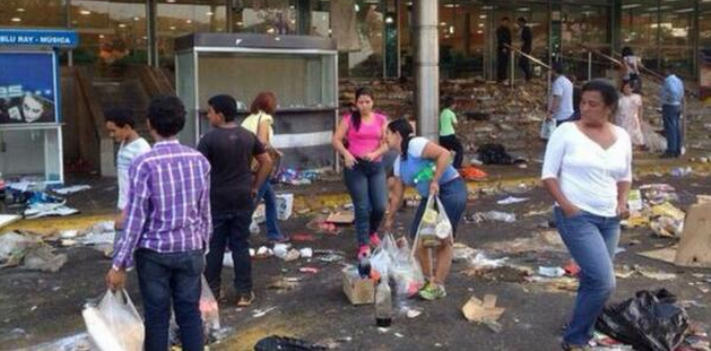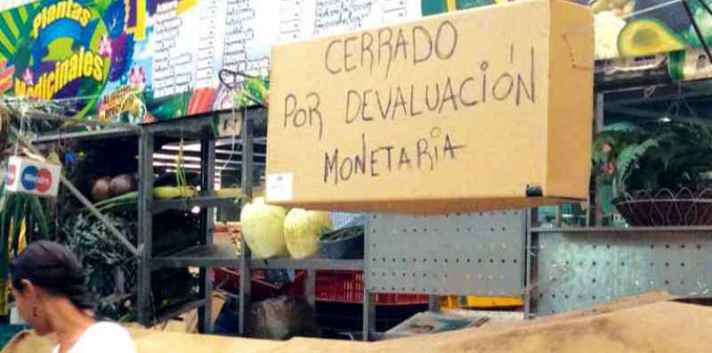Venezuela's Eminent Collapse Was Decades in the Making

Image of a looting in Venezuela sometime this year. (Runrun.es)
There are hundreds of reasons for this. The policies of economic liberalism implemented between 1930 and 1966 allowed Venezuela to grow faster than any other country in the world as a kind of China of its time. Then came the nationalization of oil in 1976 and the “Caracazo,” a series of protests and riots that shook the capital in 1989.
But overall, the current crisis has two main explanations. One is the country’s nefarious dependence on oil, which creates a population used to dependence, not real productivity. The second is that a political elite that has greatly enriched itself has not allowed general poverty to diminish. Politicians continue to exploit and plunder the country’s wealth — in particular its oil wealth — knowing that, if they lose power, they will be brought to trial both locally and internationally.
The following are 16 reasons why Venezuela is dangerously close to economic catastrophe.
1) 1992: Colonel Hugo Chávez and other military officers stage a coup d’état in February and another in November.
2) 1994: After spending only two years in prison, Chávez and other plotters are pardoned by then-President Rafael Caldera.
3) 1998: Venezuelans voters, most of them middle class voters, elect Chávez as president. They want “order” and a “strong hand” to fight crime. They are also disenchanted by an economic crisis caused by a large drop in oil prices.
4) 2001: Chávez begins to show a dangerous drift toward socialism. Thousands of Venezuelans take to the streets against him. The president declares that his government is leading a “peaceful but armed revolution.”
5) 2002: A massive protest leaves 17 dead and Chávez is ousted from power in a coup led by businessman Pedro Carmona, whose aims are still the subject of speculation. Chávez returns to power 72 hours after being ousted.
6) 2003: After a two-month strike that fails to evict Chávez from the country, the president imposes foreign exchange controls, which become more draconian with time and are still maintained today. For 13 years, Venezuelans have not had a legal foreign exchange market. The price of the Bolívar (Bs) has gone from 900 Bs to 1.2 million Bs per dollar, but international reserves have not increased.
7) 2004: Chávez holds a referendum that ratifies his term in office although the opposition claims that the vote was rigged. Skeptical international observers are never invited to observe elections again. In the same year, Chávez creates the “Bolivarian Alternative for the Americas” (ALBA) as an alternative to the FTAA, the hemispheric free trade zone proposed by the United States. ALBA includes Caribbean and Central American countries, and Venezuela sells its partners oil at discount prices with a two-year grace period and a 20-year repayment period.
8) 2005: Chávez defeats a demoralized and divided opposition which decides to abstain from the parliamentary elections, in which only 10 percent of the population vote. The president controls parliament in its entirety along with the judicial and executive branches.
9) 2006: Keeping Venezuela under tight control, Chávez wins the presidential election once again with 62 percent of the vote. The price of oil is fixed at US $100, where it would remain for almost seven years. He claims throughout his campaign that those “who voted for Chávez also voted for socialism.”
10) 2007: Immediately after his reelection, Chávez begins an aggressive policy of confiscating and expropriating private companies. He aims to control the media and the food industry while introducing constitutional reforms that would make Venezuela practically a communist country. Alarmed, Venezuelans vote No in the constitutional referendum. Chávez recognizes his defeat, but notes that he is going to continue his interventionist policies. Soon, shortages of essential commodities like milk become a problem as the food industry is one of the hardest hit by Chávez’s policies.
11) 2008-09: With oil being sold at US $140 per barrel, Chávez destroys Venezuela’s national industry with exchange controls, preventing companies from buying supplies and essential raw materials while flooding the country with cheap agricultural imports. Overpricing and corruption abound. After a serious drop in oil prices, the economy suffers. Chávez, however, passes an amendment that allows him to be reelected indefinitely. He also increases the country’s debt as China takes over large areas of the Venezuelan economy.
Between 2007 and 2016, Venezuela’s fiscal deficit amounts to at least 10 percent of GDP according to economist Luis Oliveros. The central government, which in 1998 had 800 thousand employees, now employs 3 million bureaucrats (10 percent of the population). There are 36 ministries in 2016 compared to 12 in 1998.
Also in 2009, Venezuela suffers an energy crisis for the first time. Chávez announces that he will import power plants from Cuba as an emergency measure. It is estimated that this scheme electrical costs US $40 billion, which could have been used to purchase a completely new electrical system in Venezuela. This results in abundant corruption that has never been investigated. The money, however, ended up in Andorra and Switzerland.
12) 2011: Chávez announces to the people that he has cancer but still declares himself a candidate for the next year’s presidential elections. His spending plan is so aggressive that, according to economists Ricardo Hausmann and Miguel Angel Santos, it could have been financed only with the price of oil at US $197, or US $137 more than the market price at the time. The difference was covered with debt. According to Chávez’s former planning minister Jorge Giordani, US $25 billion was lost to corruption.
13) 2012: Chávez wins the presidential election but only appears in public twice after his victory: two days after the election and on December 8, when he announces that he has to undergo surgery again. He adds that if he can’t complete his mandate, his heir Nicolás Maduro should hold power. Chávez dies on April 5, 2013, and Maduro wins a presidential election one month later although the result is again controversial. Maduro inherits an economy hit by falling oil prices. The new president maintains his predecessor’s “21st Century Socialism” agenda and continues to destroy Venezuela’s productive sector.
14) 2013: Paralyzed politically, Maduro takes no steps beyond printing money to raise the country’s fiscal deficit (many estimate at more than 20 points of GDP) and praying that oil prices rise. He also tightens foreign exchange controls to pay the foreign debt. It is estimated that the money supply increases tenfold in these three years, a process that leads to spiraling inflation.

Continuous devaluations had made the bolivar a worthless currency. (Ecopolitica)
16) 2016: Meanwhile, the return El Niño, a cyclical weather phenomenon, leads to widespread power outages across the country as the authorities’ incompetence and corruption are laid bare. 76 percent of Venezuelans have fallen into poverty and 13 percent eat only twice a day. Maduro’s government is rejected by 85 percent of the population.
Looting last week was contained but the Governor of Lara, Henri Falcón, a former Chavista, noted that “this is a thousand times worse than the reasons that led to the ‘Caracazo.’” He added that, at any moment, the political, social and economic crisis may lead to a conflict of incalculable consequences.
No comments:
Post a Comment